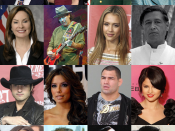Hispanic American Diversity
Although there are many different ethnic groups who speak Spanish it is not uncommon to hear them all grouped together as Hispanic or Latino. These groups are from many different countries and cultures. The three most populous groups of Spanish speaking ethnic groups in the United States are, in order by density, Mexican, Puerto Rican and Cuban. Then you have Spanish speaking ethnic groups from Central and South America. The only thing that some of these Spanish speaking ethnic groups have in common is language, their cultures can be as different from each other as from any other non-"Hispanic" group.
Mexican Americans
The diaspora of Mexican Americans encompasses many avenues, from those who found themselves on the wrong side of the border after the U.S. Mexican war to those who have paid their life savings to be secreted across the border. The Mexican American comes from a culture as rich and diverse as the USA's.
People of Mexican heritage share a rich cultural blend of influences as varied as the indigenous Yaqui and Apache nations, ancient Aztecs and Mayans, and Spanish aristocracy (WLIW New York, 2007). The Mexican American family is very close knit and the closeness includes extended family. The culture of Mexican American families usually includes deep religious beliefs and traditions. The most predominant religion among Mexican Americans is Catholic. Chicano English is the term used for the common language of the Mexican American. According to linguist Carmen Frought it is an established English dialect spoken by even those Mexican Americans who know little or no Spanish. Frought says, "It would be a mistake to characterize Chicano English as "learner English", somehow imperfect and non-native. Chicano English is a stable and fully-formed dialect, linguistically and structurally equivalent to other dialects of English, such as the...


